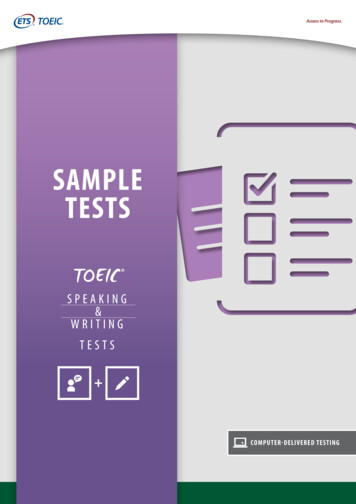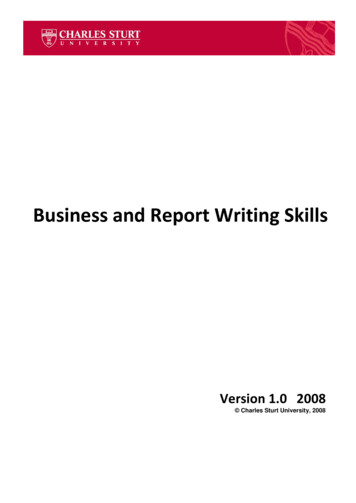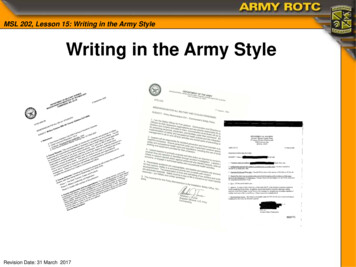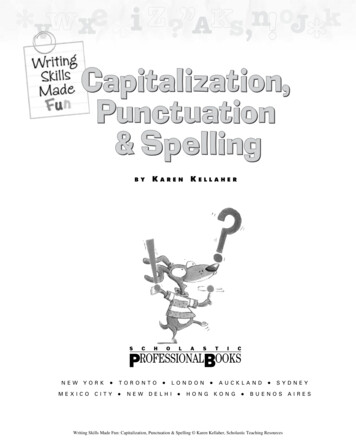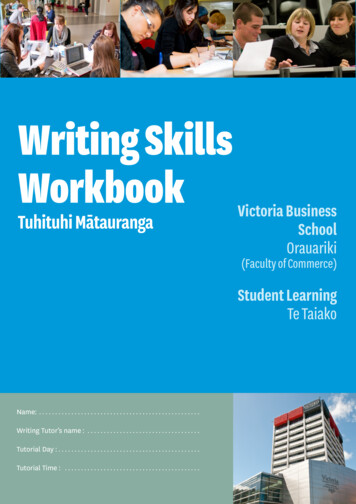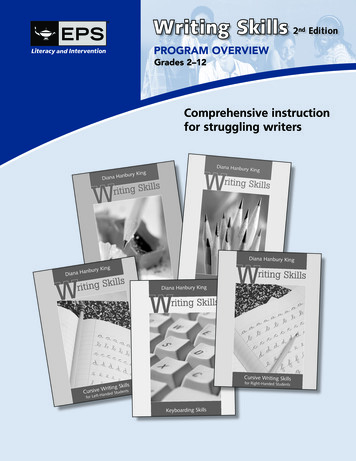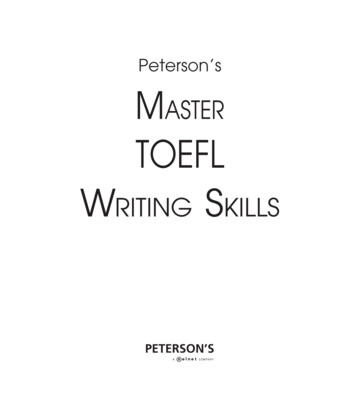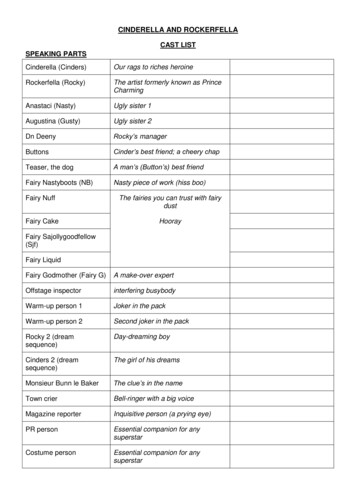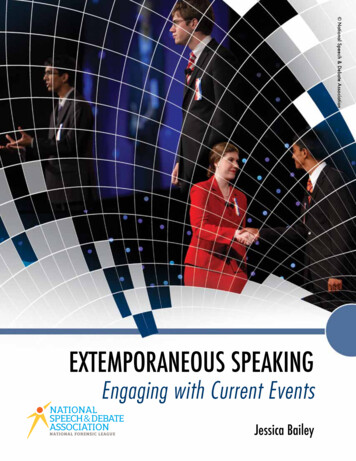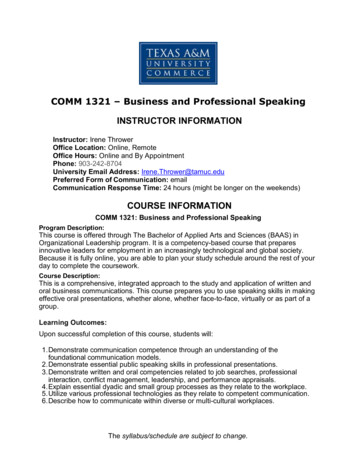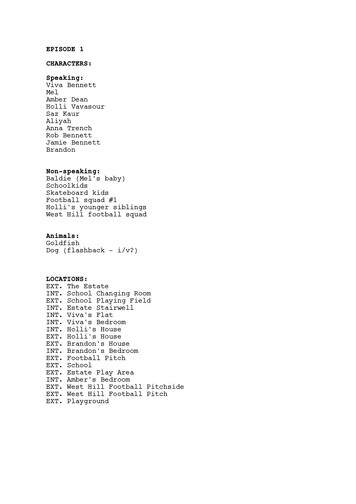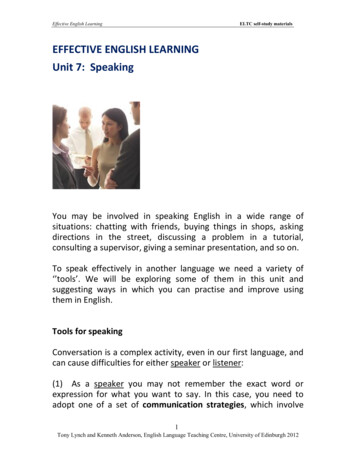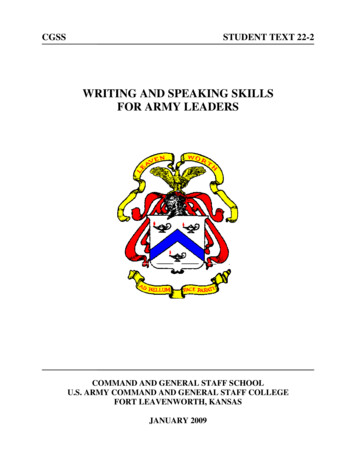
Transcription
CGSSSTUDENT TEXT 22-2WRITING AND SPEAKING SKILLSFOR ARMY LEADERSCOMMAND AND GENERAL STAFF SCHOOLU.S. ARMY COMMAND AND GENERAL STAFF COLLEGEFORT LEAVENWORTH, KANSASJANUARY 2009
This page is intentionally left blank.
CGSSSTUDENT TEXT 22-2PREFACEThe Army recognizes your potential to perform successfully as a leader. You continue to develop yourskills, strengthen your values in light of Army values and the operational environment, and focus yourattention on your own leadership attributes. Chief among these is the skill of communicating yourpurpose, vision, and intent to others through writing and speaking. The Command and General StaffOfficer Course (CGSOC) Intermediate Level Education (ILE) Common Core (CC) and AdvancedOperations and Warfighting Course (AOWC) studies require you to continue examining andstrengthening your skills, values, and attributes while preparing for senior leadership responsibilities.One common task is to think critically and creatively as you research and write papers or prepare andpresent briefings. The purposes of this student text are to— Serve as a refresher on the basics of writing.Present a standard method for documenting sources.Identify a standard method for formatting documents.Provide standard references supporting effective writing and speaking.To meet these purposes— Chapter 1 reviews the Army standard, the principles of good writing, and the process ofcommunication.Chapter 2 examines the elements of effective writing from the initial tasking to the final productand presents a standardized method for documenting sources.Chapter 3 considers the elements of effective speaking and how to enhance your presentations.The appendixes (apps) provide examples, references, and specific tips on writing and speaking.While providing an overview of the writing and speaking skills required of military leaders, this is not acomprehensive guide to mastering those competencies. It focuses on types of written and speakingproducts required during the ILE CC and the AOWC.Unless this publication states otherwise, masculine pronouns do not refer exclusively to men.We encourage everyone who reads this student text to recommend changes to keep the text current andhelpful. Address your comments to:US mail:Director of Academic OperationsATTN: CGSS OperationsCommand and General Staff SchoolU.S. Army Command and General Staff CollegeLewis and Clark Center Room 4502100 Stimson AveFort Leavenworth, KS 66027-1352Telephone: Defense Switched Network (DSN) 552-7311; commercial (913) 684-7311Email: michael.robinson39@us.army.milST22-2 Jan09ns-i-
CGSSSTUDENT TEXT 22-2This page is intentionally left blank.-ii-ST22-2 Jan09ns
CGSSSTUDENT TEXT 22-2WRITING AND SPEAKING SKILLS FOR ARMY LEADERS 1Preface.PageiReferences.vChapter 1.Communication Skills for Army Leaders .1-1The Army Standard for Communications .Critical Thinking, Creative Thinking, Decision Making, and Problem Solving .Principles of Good Writing .Leader Responsibilities .1-11-11-21-3Effective Writing—Tasking to Final Product .2-1Steps to Effective Writing .Step 1. Research .Step 2. Plan .Step 3. Draft .Step 4. Revise .Step 5. Proof .2-12-22-52-92-92-13Effective Speaking—Tasking to Final Presentation .3-1Communication Model.Research .Issue .Requirement .Role .Audience .Setting .Timing .Plan.Draft .Revise .Rehearse .Conduct -9Appendix A. Writing Style and Concise Department of Military History (DMH) Style Guide .A-1Appendix B. Simpler Words and Phrases .B-1Appendix C. Assessing Writing .C-1Appendix D. Assessing Speaking and Presentations .D-1Appendix E. Military Briefing Guides .E-1Appendix F. Speaking Tips .F-1Appendix G. Essay Format .G-1Chapter 2.Chapter 3.Index.Index-11This student text supersedes Student Text 22-2, Writing and Speaking Skills for Leaders at theOrganizational Level, April 1998.ST22-2 TOC Jan09ns-iii-
CGSSSTUDENT TEXT 22-2This page is intentionally left blank.-iv-ST22-2 Jan09ns
CGSSSTUDENT TEXT 22-2REFERENCESBons, Col Paul M., United States Army, Editor in Chief. Leadership in Organizations. West Point, NewYork: U.S. Military Academy Department of Behavioral Sciences and Leadership, circa 1981.Command and General Staff College (CGSC) 350-5, Student Handbook. Fort Leavenworth, KS.Leggett, Glenn, David C. Mead, and Melinda G. Kramer. Prentice Hall Handbook for Writers (12th ed.).Englewood Cliffs, New Jersey: Prentice Hall, 1994.Strunk, William Jr, and White, E.B. The Elements of Style (3rd ed.) New York: Macmillan PublishingCompany, 1979.Turabian, Kate L. A Manual for Writers of Research Papers, Theses, and Dissertations (7th ed.). Rev. byWayne C. Booth, Gregory G. Colomb, and Joseph M. Williams. Chicago, IL: The University ofChicago Press, 2007.U.S. Department of the Army Regulation 25-50, Preparing and Managing Correspondence. Washington,DC, June 2002.U.S. Department of the Army Field Manual 5-0, Army Planning and Orders Production. Washington,DC, January 2005.U.S. Department of the Army Pamphlet 600-67, Effective Writing for Army Leaders. Washington, DC,June 1986.ST22-2 Jan09ns-v-
CGSSSTUDENT TEXT 22-2This page is intentionally left blank.-vi-ST22-2 Jan09ns
CGSSSTUDENT TEXT 22-2CHAPTER 1COMMUNICATION SKILLS FOR ARMY LEADERS1-1. Mission accomplishment requires skilled leaders able to make the right decision. Individuals whotransmit their intent and ideas so that others understand the message and act on it possess one of theprimary qualities of leadership—the ability to communicate clearly. Your success as a military leaderdepends partially on your ability to think critically and creatively and to communicate your intention anddecision to others. This student text focuses on how you arrive at your decision and communicate it toothers.THE ARMY STANDARD FOR COMMUNICATIONS1-2. Effective Army writing transmits a clear message in a single, rapid reading and is generally free oferrors in grammar, mechanics, and usage. Good Army writing is concise, organized, and right to thepoint. Two essential requirements include putting the main point at the beginning (bottom line up front(BLUF)) and using the active voice. Active voice writing emphasizes the doer of the action, shows whoor what does the action in the sentence, and creates shorter sentences.1-3. The standard also holds true for verbal communications. It means that by the time you finishpresenting information or a course of action, your subordinates, peers, and superiors should know yourintent and understand your recommendation or decision. Effective Army writing and communication arebased on applying critical thinking, creative thinking, decision making, and problem solving skills tosolve complex problems.CRITICAL THINKING, CREATIVE THINKING, DECISION MAKING,AND PROBLEM SOLVING1-4. Critical thinking helps us to judge what is true and is an essential tool in solving complex problems.Critical thinking is thorough and involves all elements of reasoning. Critical thinking is rigorous inapplying high standards to identify and evaluate evidence to guide decision making. Critical thinkingrequires that you analyze the task, identify your goal(s), and clarify the problem you need to solve. Thisincludes considering the many perspectives influencing the task. You also need to recognize that the data(information, evidence, facts, observations, or experiences) you work with may be incomplete. Criticalthinking requires that you examine your assumptions and those of others, as well as the inferences,conclusions, implications, and consequences of those assumptions.1-5. Creative thinking is specific thought processes which improve our ability to be creative. It is thinkingdeliberately in ways to improve the likelihood of new thoughts occurring. Creative thinking maximizesthe ability of the brain to think of new ideas and explore multiple avenues of actions or thoughts. It asksyou to identify those inhibitors that focus your thinking along predetermined paths. Inhibitors includeperceptions, culture, environment, emotions, intellect, and "idea killers" (usually expressed in suchphrases as "We already tried that," "It would take too long," "The commander would never support it," "Ihave enough information," etc). Successful creative thinking never takes place in a vacuum; it builds oncritical thinking skills.1-6. Decision making is the cognitive process of making choices or reaching conclusions. Sound decisionmaking is rooted in applying critical thinking skills and creative thinking processes to solve complexST22-2 Jan09ns1-1
CGSSSTUDENT TEXT 22-2problems. The critical reasoning and thinking standards help you evaluate your reasoning and thinking forclarity, accuracy, precision, relevance, depth, breadth, logic, significance, and fairness.1-7. Problem solving is a daily activity for Army leaders. Army problem solving is a systematic way toarrive at the best solution to a problem. Figure 1-1 shows seven problem solving steps:Seven Step Problem Solving ModelCONTINUALLYASSESS1. ID the Problem Who, What , When, Where, Why2. Gather Information Facts, Assumptions, Interests LinkedScreening and Evaluation3. Develop CriteriaSuitable, Feasible, Acceptable4. Generate Possible Solutions Distinguishable and CompleteBenchmark – End State?5. Analyze Possible SolutionsDetermine Best COA6. Compare Possible SolutionsDecide and Act7. Make and Implement the DecisionFigure 1-1. Seven-step problem solving model.PRINCIPLES OF GOOD WRITING1-8. Army Regulation 25-50 requires that writers incorporate the following principles into theircommunications–SHORT, SENSIBLESENSIBLE SENTENCESSHORT,SENTENCESAND PARAGRAPHSPARAGRAPHSANDEFFICIENT PHRASES,VOCABULARY, AND IMAGESACTIVE VOICE (PRIMARILY)PACKAGING THAT SUPPORTSFigure 1-2. Principles of good writing.Short, Sensible Sentences and Paragraphs1-9. Effective writers employ both long and short sentences; however, the average sentence should beabout15 words long. The same holds true for paragraph length. Some paragraphs may be 2 inches indepth while others less than an inch, but the average paragraph will be about 1 inch (about 6 lines) deepfor a single-spaced document.1-2ST22-2 Jan09ns
CGSSSTUDENT TEXT 22-2Efficient Phrases, Vocabulary, and Images1-10. Use commonly accepted words and word pictures. Avo
1-2. Effective Army writing transmits a clear message in rapid readinga single and is generally free of , errors in grammar, mechanics, and usage. Good Army writing is concise, organized, and right to the point. Two essential requirements include putting the main point at the beginning (bottom line up front (BLUF)) and using the active voice. Active voice writing emphasizes the doer of the action, shows whoFile Size: 561KBPage Count: 76
